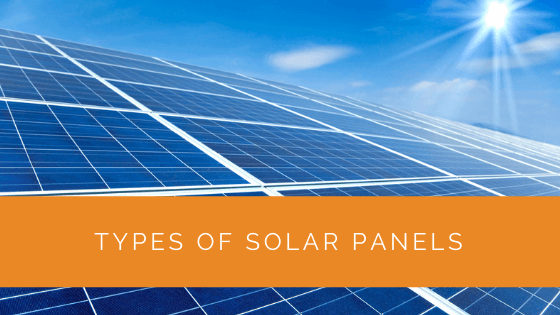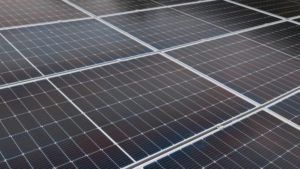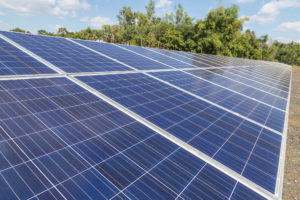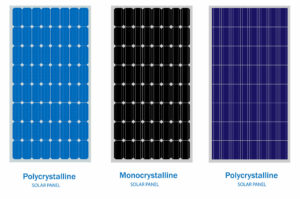Solar panels have revolutionised how we harness energy from our most abundant natural source: the sun. Understanding the various types of solar panels is crucial for anyone considering harnessing this renewable energy source. In this informative guide, we will demystify the world of solar panels, breaking down the differences between monocrystalline, polycrystalline, thin-film, and even PERC panels. Whether you’re a homeowner looking to reduce electricity bills or a business owner planning a large-scale installation, this comprehensive article will help you make an informed choice by highlighting the strengths and weaknesses of each solar panel type. So, let’s dive into the fascinating world of solar energy and explore the options that best suit your needs and budget.
Contents
- 1 Key Takeaways
- 2 What Is a Solar Panel?
- 3 Types of Solar Panels
- 4 Major Types of Solar Panels
- 5 Monocrystalline Solar Panel
- 6 Polycrystalline Solar Panels
- 7 Thin-Film Solar Panels
- 8 What Are Passivated Emitter and Rear Cell (PERC) Solar Panels?
- 9 Which Companies Manufacture Solar Panels in the UK?
- 10 What Solar Panel Type Is the Most Suitable for You?
- 11 Case Study: Evaluating the Optimal Solar Panel Type for a Mixed-Use Development
- 12 Expert Insights From Our Solar Panel Installers About Types of Solar Panels
- 13 Discover the Power of Solar with Solar Panels Network
- 14 Final Thoughts
Key Takeaways
- Solar panels are a transformative energy source that converts sunlight into electricity, and there are four main types: monocrystalline, polycrystalline, thin-film, and PERC panels.
- Monocrystalline panels offer high efficiency and durability but come at a higher cost, while polycrystalline panels are cost-effective but less efficient.
- Thin-film panels are flexible and cost-effective but may have shorter lifespans, making panel choice crucial based on specific needs and property size.
What Is a Solar Panel?
Before jumping into solar panels’ complexities, types and features, let’s understand what solar panels are. Sun is the best natural source of energy. Solar panels are rectangular (or any other shape) sheets that convert sunlight into electrical energy.
Now, if you are wondering how this happens, here’s how. Solar energy or sunlight comprises photons, which can efficiently be used to power electricity.
The converted energy can later be used for various tasks, from plugins for various sources to personal and commercial energy usage and so much more. Also known as photovoltaics, solar panels can facilitate remote areas with electricity and energy.
Types of Solar Panels
There are four main types of solar panels, varying in appearance, overall performance, cost-effectiveness, and the installation process to determine if the solar panel meets the requirements. This comprehensive guide will highlight the strengths and weaknesses of all three main types of solar panels.
The three main types of solar panels include monocrystalline, polycrystalline, and thin-film. To get an insight into the four types, read on!
Major Types of Solar Panels
| Solar Panel Type | Pros | Cons |
|---|---|---|
| Monocrystalline | High efficiency, long-lasting and performance | Expensive |
| Polycrystalline | Budget-friendly | Workable efficiency and performance |
| Thin-film | Portable and flexible | Workable efficiency and performance |
Monocrystalline Solar Panel
The first type of solar panel has to be the most familiar one, the Monocrystalline Solar Panel. These solar panels are made of soft, pure silicon crystals. Thus, it is slightly on the expensive side. Furthermore, to ensure that the solar panel appears to be closely knit, wafers are assembled into rows and columns to form a rectangle, covered with a glass sheet and put together into a frame.
Only the monocrystalline is made from pure silicone, making them stand out as their dark black colour can easily identify them. Furthermore, since silicon is much more durable and long-lasting than any other material, monocrystalline is the most efficient and long-lasting among all three solar panel types.
The only demerit of monocrystalline cells is that they are slightly more expensive than others. Also, silicon is an important factor when buying a monocrystalline, which can range as high as 50% to be accurate. The best part is that the monocrystalline solar panels have many benefits:
- High-efficiency rate, over 20%
- High power output
- Long-lasting and durable
- Easy to install and maintain
- Can withstand high temperatures

Monocrystalline Solar Panel Appearance
Monocrystalline panels are black cells you often see around since they are the most commonly used solar panels. This doesn’t mean that the Monocrystalline Solar Panel comes only in black. Black is the colour of the cell. You can buy the sheets and the frames in several colours. However, the back sheet comes in options like silver, white and black, while frames are black or silver. And lastly, The pure silicon crystal makes the cells seem black due to light interactions with crystals.
Monocrystalline Solar Panels Efficacy
The efficacy of monocrystalline solar panels is the best and highest compared to others. With an efficacy rate of 20%, the results provided by these solar panels remain surpassing to date. Furthermore, monocrystalline has a better wattage, the average wattage being around 300w to 400w (watts). This rate and wattage also allow monocrystalline to generate more power. Monocrystalline solar panels have 60 cells and 72-96 cell variants, another reason behind their potential to produce more electricity than Polycrystalline and thin film.
Monocrystalline Solar Panels Cost
Monocrystalline Solar Panels are more on the pricey side as compared to other panels. The reason is the time-consuming manufacturing process and, of course, the pure crystals of silicon that add to its efficiency and performance. Furthermore, the Czochralski process is used to sieve out the impure ones to extract the most refined quality silicon crystals. The leftover ones are later used in the manufacturing of polycrystalline.
Polycrystalline Solar Panels
Next up, the polycrystalline solar panels. As you might have figured, the name defines these solar panels as made of different silicon crystals instead of one. The silicon pieces are melted down to liquids and later poured into square moulds per the requirements.
This is why Polycrystalline Solar Panels cost much less than monocrystalline since there is absolutely zero wastage of any materials, especially silicon. But, again, every positive attribute has a negative side, and so does this.
Since the silicon fragments are impure, the polycrystalline panels are less efficient and have significantly lesser heat tolerance than the monocrystalline ones. Also, if you love some colours, Polycrystalline Solar panels come in all sorts of colours. However, they are still the best in warm surroundings and high-temperature environments.
- Efficiency is pegged at 15%
- Less costly than Mono-SI panels

Polycrystalline Solar Panels Appearance
The blue-coloured cells you see are the Polycrystalline Solar Panels. This is because the light-reflecting way for a Polycrystalline Solar Panel is slightly different from that of a monocrystalline. Another reason behind the bluish tones is the impure crystal fragments of silicon, which are pure in monocrystalline; like monocrystalline, polycrystalline panels have colour options for back sheets and frames, usually silver, white and black.
Polycrystalline Solar Panels Efficacy
The efficacy of polycrystalline solar panels is only second to monocrystalline. With an efficacy rate of 17%, Polycrystalline solar panels provide users with decent results. In terms of wattage, Polycrystalline panels are not as good as monocrystalline panels, but they are workable at 100w to 400w. An adequate rate and wattage allow Polycrystalline panels to generate ample power. Like Monocrystalline, Polycrystalline solar panels have 60 cells and 72-96 cell variants. Although the electricity produced is fair, the potential is less satisfying than the Monocrystalline solar panels.
Polycrystalline Solar Panels Cost
Polycrystalline solar panels are decently priced. So, yes, they won’t burn holes in your pockets. Furthermore, polycrystalline solar panels cost less because these are created from the fragments and remains of the sieved-out silicon crystals, eventually reducing the manufacturing cost and, thus, being inexpensive.
Thin-Film Solar Panels
Thin-film solar panels are produced by combining multiple photovoltaic films onto a base. Their advantages notwithstanding, thin-film solar panels take up a lot of space, making them unsuitable as solar panels for your home.
There are many benefits that thin-film solar panels bring to the table, such as:
- Easy production
- Cost-effective
- Not ideal for residential use
- Perform well under high temperatures
Furthermore, these thin-film solar panels are incredibly flexible and lightweight, making installation much easier and less laborious than the traditional silicon solar panels. In addition, the thin-film solar panels contain a minimum quantity of silicon compared to that caused by Solar panels.
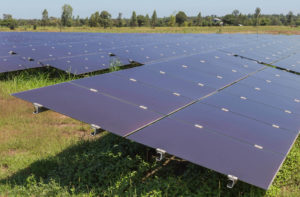
Thin-Film Solar Panels Appearance
As the name suggests, these solar panels are considerably thin compared to the others. Perhaps this is why they are less efficient than monocrystalline solar panels, whose cells are thicker. However, buying a thin-film solar panel doesn’t necessarily mean you will get a thin one since the frames are usually the same regardless of the type. Finally, if you prioritise appearance over efficacy, Thin-film Solar Panels are the best for you; they are sleek and well-designed to beautify your space.
Thin-film Solar Panels Efficacy
The Thin-film solar panel’s stellar feature is its temperature coefficient. To break it down, when the temperature of a solar panel rises, it tends to produce a lesser amount of electricity, which means the temperature for monocrystalline and polycrystalline falls about -0.3% to -0.5% per °C.
However, Thin-film solar panels notice a decrease of just -0.2% per °C. Thus, Thin-film panels are more efficient at handling heat than other panel types. However, their warranty span is considerably shorter, making them highly inappropriate for long-term usage.
Thin-film Solar Panels Cost
The cost for thin-solar panels is not defined. Meaning it depends on the type and quality of the film. However, because of its sleek design and lightweight build, installing thin films costs much less labour-intensive than monocrystalline and polycrystalline. All this eventually cuts down the cost.
What Are Passivated Emitter and Rear Cell (PERC) Solar Panels?
PERC solar panels are an improvement of an existing type of solar panels. Old models are usually filled with shortcomings and minor problems. Thus, new models are made to revamp the existing features and some of the latest tweaks and touches to ensure a smooth user experience.
The PERC Solar panels, for example, are much more efficient than monocrystalline solar panels since they reflect the light into the cell, amplifying the number of solar radiations getting absorbed. In addition to this, it also allows greater wavelengths of light to be reflected. However, silicon is not capable of absorbing light waves over 1180nm. Subsequently, they have a metal back sheet, reducing their efficiency. PERC has proved beneficial, and it is for all the right reasons.
This is an old cell model, but the current trends have revived it. Passivated Emitter and Rear Cells (PERC) are again used in solar panels.
- Much more efficient
- Absorbs radiation up to 1180 nm
- Absorbs much more radiation than traditional models

Which Companies Manufacture Solar Panels in the UK?
The manufacturers of Solar Panels are increasing with the skyrocketing demands as climate change takes over. However, the leading solar panel manufacturers are based outside the UK, primarily in Asia and European countries like Germany and Austria.
There are some reliable manufacturers in the UK as well. Most manufacturers in the UK import the cells for solar panels and assemble them at the borders later. Here are the options if you are looking for manufacturers in the UK.
- Viridian Solar: Viridian Solar is a trusted name that fulfils all your solar panel requirements. The company comes from Cambridge manufacturers and offers quality service from purchase to installation.
- GB-SoI: Another trusted name, standing strong over the past 20 years. GB-Sol is one of the few companies that manufactures its photovoltaic panels for off-grid systems and covers residential and commercial installations.
- Romag: If you are looking for a reliable and trusted brand, Romag is the one to choose. Based in England, the company has existed for over 78 years. They deal in all kinds of solar panel products and BIPVs.
- Solarcentury: Based in the heart of England, London. Solarcentury deals in solar tiles (C21e) and BIPVs. If you need any of the two, look no further.
Other mentions for Solar Panel Manufacturers in the UK: AES Solar, Polysolar, SunSolar Energy and Solution are the other big names that headline the solar panel manufacturing scene in the UK.
For installing solar panels at your residence or office building, make sure only to contact credible and reliable solar panel installers. In this way, your household will become eligible for the UK government’s feed-in tariff income scheme.
What Solar Panel Type Is the Most Suitable for You?
Installing solar panels is a significant decision, and it’s not something you do often. So, choosing the right kind is important based on your needs. There are three main types of solar panels, each with strengths and weaknesses. Consider your property size and what you want from your solar panels to make the best choice.
For example, monocrystalline solar panels are a great choice if you have a small space and want to reduce your electricity bills. On the other hand, if you’re planning to install solar panels on a big commercial site, thin-film panels can be a cost-effective option.
Case Study: Evaluating the Optimal Solar Panel Type for a Mixed-Use Development
Background
At Solar Panels Network, we were approached by a client developing a mixed-use property, including residential apartments and commercial spaces. The client wanted to maximise the energy efficiency of the building by incorporating a solar PV system. However, the project’s scope required careful consideration of the most suitable type of solar panels, balancing efficiency, cost, and aesthetic integration.
Project Overview
The primary objective was to identify and install the best-suited solar panels that could cater to the energy needs of both the residential and commercial units within the development. The project also aimed to enhance the building’s sustainability credentials while ensuring a reasonable return on investment for the client.
Implementation
- Energy Needs Assessment: We conducted a comprehensive analysis of the building’s expected energy consumption, considering the mixed-use nature of the development.
- Site Evaluation: Our team assessed the available roof and façade space, determining the potential for solar panel installation and identifying any shading or structural challenges.
- Panel Selection: Based on the energy needs and space constraints, we recommended a combination of monocrystalline panels for the limited roof space and thin-film panels for the building’s expansive south-facing façade.
- Installation: We coordinated the installation, ensuring that the monocrystalline panels were strategically placed to maximise sun exposure, while the thin-film panels provided additional capacity without compromising the building’s aesthetics.
- Integration and Testing: The solar PV system was integrated with the building’s energy infrastructure, and thorough testing was conducted to ensure optimal performance and efficiency.
Results
- Enhanced Energy Efficiency: The hybrid approach of using both monocrystalline and thin-film panels resulted in a 25% increase in energy efficiency compared to using a single panel type.
- Cost Savings: The selected panel types allowed for a balanced investment, offering high efficiency in critical areas and cost-effective coverage where space was less of an issue.
- Sustainability Impact: The installation significantly reduced the building’s carbon footprint, aligning with the client’s sustainability goals and enhancing the property’s appeal to eco-conscious tenants and businesses.
Summary
This project showcased the importance of selecting the appropriate type of solar panels based on specific needs and conditions. By leveraging the strengths of monocrystalline panels in limited spaces and the versatility of thin-film panels for larger surfaces, we provided a comprehensive solution that met the client’s energy efficiency and cost-saving objectives. At Solar Panels Network, we specialise in tailoring our solutions to the unique requirements of each project, ensuring optimal performance and sustainability outcomes.
Expert Insights From Our Solar Panel Installers About Types of Solar Panels
Choosing the right type of solar panel can significantly impact your energy efficiency and cost savings. For those with limited space, monocrystalline panels are an excellent choice due to their high efficiency, allowing you to get the most out of your installation.
Senior Solar Panel Installer
Polycrystalline panels are a great middle-ground solution for those looking for cost-effective options. They provide a good balance of efficiency and affordability, making them suitable for larger installations where space is not a constraint.
Renewable Energy Specialist
Thin-film panels are perfect for commercial setups where space is ample, and the installation needs to be lightweight. While they may not match the efficiency of silicon-based panels, their flexibility and cost advantages make them a viable option for many projects.
Solar Energy Consultant
Discover the Power of Solar with Solar Panels Network
Are you navigating the world of solar installations? Look no further than Solar Panels Network, the UK’s trusted partner in harnessing the sun’s potential. Our dedication goes beyond just installations; we’re on a mission to transform how homeowners and businesses across the UK perceive and utilise energy. By choosing us, you’re reducing your carbon footprint and making a smart financial move that promises savings for years ahead. Contact us today and embark on your solar journey.
Final Thoughts
Solar panels have brought about a revolutionary change in how we harness energy from the sun, our most abundant natural resource. Understanding the various types of solar panels is crucial for those looking to tap into this renewable energy source. This comprehensive guide has delved into the world of solar panels, shedding light on the differences between monocrystalline, polycrystalline, thin-film, and PERC panels, empowering homeowners and businesses to make informed decisions about their energy needs.
The three main types of solar panels, monocrystalline, polycrystalline, and thin-film, offer unique advantages and disadvantages. Monocrystalline panels stand out for their high efficiency and durability, while polycrystalline panels are cost-effective. Thin-film panels offer flexibility and cost savings but may have shorter lifespans, making panel choice a critical consideration based on specific requirements and property size. Additionally, PERC panels represent an efficient improvement over traditional models, absorbing more light and offering greater efficiency.
When selecting the right solar panel type, it’s essential to consider your property’s size and your specific energy goals. Monocrystalline panels may be ideal for reducing electricity bills in smaller spaces, while thin-film panels could be a cost-effective choice for larger commercial installations. Regardless of your choice, solar panels have paved the way for a sustainable future by harnessing the sun’s power to meet our energy needs.
About the Author
Solar Panels Network stands at the forefront of solar energy solutions, driven by a team of seasoned solar engineers and energy consultants. With over decades of experience in delivering high-quality solar installations and maintenance, we are committed to promoting sustainable energy through customer-centric, tailored solutions. Our articles reflect this commitment, crafted collaboratively by experts to provide accurate, up-to-date insights into solar technology, ensuring our readers are well-informed and empowered in their solar energy decisions.

